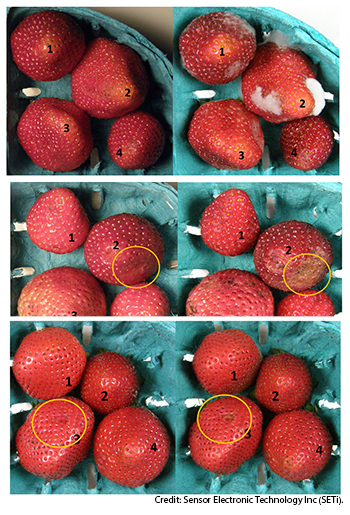
(Top) The control sample shows mold growth on the strawberries after seven days. (Middle) UVC treatment exacerbated existing damage in the strawberries even while inhibiting mold growth. (Bottom) UVB (equal energy) treatment prevents damaged areas from spreading while also inhibiting mold growth.
Fruit lovers want to eat strawberries that are fresh and ripe, not moldy and rotten. A new study discussed at this week’s CLEO: 2013 conference shows that low-level exposure to ultraviolet light could double the shelf life of these nutritious berries.
Steven Britz, a food researcher for the U.S. Department of Agriculture bought several tubs of strawberries from supermarkets and stored them in conditions similar to those found in home refrigerators: temperature near 5 °C and relative humidity above 95 percent. Half of the berries were in the dark and the other half were illuminated with low levels of UV light with peak emission at 272, 289 or 293 nm (near the short end of the so-called UVB range and the long end of the UVC range).
Mold began to grow on the strawberries in dark storage after six days and covered much of their surface by nine days. The berries stored under the ultraviolet LEDs, however, did not sprout the dreaded fuzzies. Further tests showed that the illuminated berries had lost about 5 percent of their weight after nine days, but still retained 6 percent more anthocyanins than the dark-stored fruit. Anthocyanins are the brilliant pigments that not only give berries their color but may have antioxidant properties for good health.
The USDA researcher used low-power UV aluminum gallium nitride LEDs from Sensor Electronic Technology Inc. of Columbia, S.C. (U.S.A.). Britz says the technology is a natural for home refrigerators and supermarket displays, since solid-state devices are more efficient at cold temperatures than traditional lamps. The company and the agency are working with refrigerator manufacturers to incorporate the LEDs in future designs as a way to preserve fresh produce and reduce food spoilage.

Quantum dots with conjugated polymer and ligand enhancement chemistry.
In other news from CLEO: 2013, scientists from the University of Louisville (U.S.A.) figured out how to print hybrid quantum-dot LEDs on an inkjet printer. The group, led by associate professor of chemical engineering Delaina Amos, modified cadmium selenide and cadmium selenide/zinc sulfide quantum dots to work with types of conducting polymers used in organic LEDs. Inkjet deposition created the thin layers necessary to control the phase separation between the layers.
The conference continues through 14 June in San Jose, Calif. (U.S.A.).
